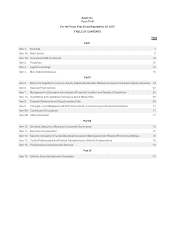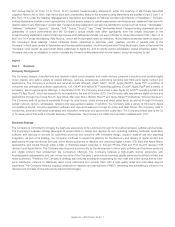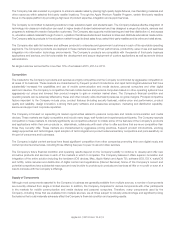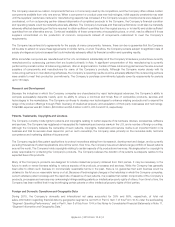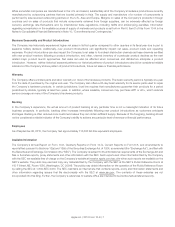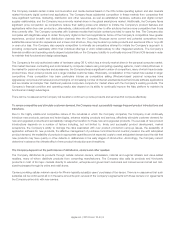Apple 2015 Annual Report Download - page 12
Download and view the complete annual report
Please find page 12 of the 2015 Apple annual report below. You can navigate through the pages in the report by either clicking on the pages listed below, or by using the keyword search tool below to find specific information within the annual report.Many resellers have narrow operating margins and have been adversely affected in the past by weak economic conditions. Some resellers
have perceived the expansion of the Company’s direct sales as conflicting with their business interests as distributors and resellers of the
Company’s products. Such a perception could discourage resellers from investing resources in the distribution and sale of the Company’s
products or lead them to limit or cease distribution of those products. The Company has invested and will continue to invest in programs
to enhance reseller sales, including staffing selected resellers’ stores with Company employees and contractors, and improving product
placement displays. These programs could require a substantial investment while providing no assurance of return or incremental
revenue. The financial condition of these resellers could weaken, these resellers could stop distributing the Company’s products, or
uncertainty regarding demand for some or all of the Company’s products could cause resellers to reduce their ordering and marketing of
the Company’s products.
The Company faces substantial inventory and other asset risk in addition to purchase commitment cancellation risk.
The Company records a write-down for product and component inventories that have become obsolete or exceed anticipated demand or
net realizable value and accrues necessary cancellation fee reserves for orders of excess products and components. The Company also
reviews its long-lived assets, including capital assets held at its suppliers’ facilities and inventory prepayments, for impairment whenever
events or circumstances indicate the carrying amount of an asset may not be recoverable. If the Company determines that impairment has
occurred, it records a write-down equal to the amount by which the carrying value of the assets exceeds its fair value. Although the
Company believes its provisions related to inventory, capital assets, inventory prepayments and other assets and purchase commitments
are currently adequate, no assurance can be given that the Company will not incur additional related charges given the rapid and
unpredictable pace of product obsolescence in the industries in which the Company competes.
The Company must order components for its products and build inventory in advance of product announcements and shipments.
Consistent with industry practice, components are normally acquired through a combination of purchase orders, supplier contracts and
open orders, in each case based on projected demand. Where appropriate, the purchases are applied to inventory component
prepayments that are outstanding with the respective supplier. Purchase commitments typically cover forecasted component and
manufacturing requirements for periods up to 150 days. Because the Company’s markets are volatile, competitive and subject to rapid
technology and price changes, there is a risk the Company will forecast incorrectly and order or produce excess or insufficient amounts of
components or products, or not fully utilize firm purchase commitments.
Future operating results depend upon the Company’s ability to obtain components in sufficient quantities.
Because the Company currently obtains components from single or limited sources, the Company is subject to significant supply and
pricing risks. Many components, including those that are available from multiple sources, are at times subject to industry-wide shortages
and significant commodity pricing fluctuations. While the Company has entered into agreements for the supply of many components,
there can be no assurance that the Company will be able to extend or renew these agreements on similar terms, or at all. A number of
suppliers of components may suffer from poor financial conditions, which can lead to business failure for the supplier or consolidation
within a particular industry, further limiting the Company’s ability to obtain sufficient quantities of components. The effects of global or
regional economic conditions on the Company’s suppliers, described in “Global and regional economic conditions could materially
adversely affect the Company” above, also could affect the Company’s ability to obtain components.Therefore, the Company remains
subject to significant risks of supply shortages and price increases.
The Company and other participants in the markets for mobile communication and media devices and personal computers also compete
for various components with other industries that have experienced increased demand for their products. The Company uses some
custom components that are not common to the rest of these industries. The Company’s new products often utilize custom components
available from only one source. When a component or product uses new technologies, initial capacity constraints may exist until the
suppliers’ yields have matured or manufacturing capacity has increased. Continued availability of these components at acceptable prices,
or at all, may be affected for any number of reasons, including if those suppliers decide to concentrate on the production of common
components instead of components customized to meet the Company’s requirements. The supply of components for a new or existing
product could be delayed or constrained, or a key manufacturing vendor could delay shipments of completed products to the Company.
Apple Inc. | 2015 Form 10-K | 10


